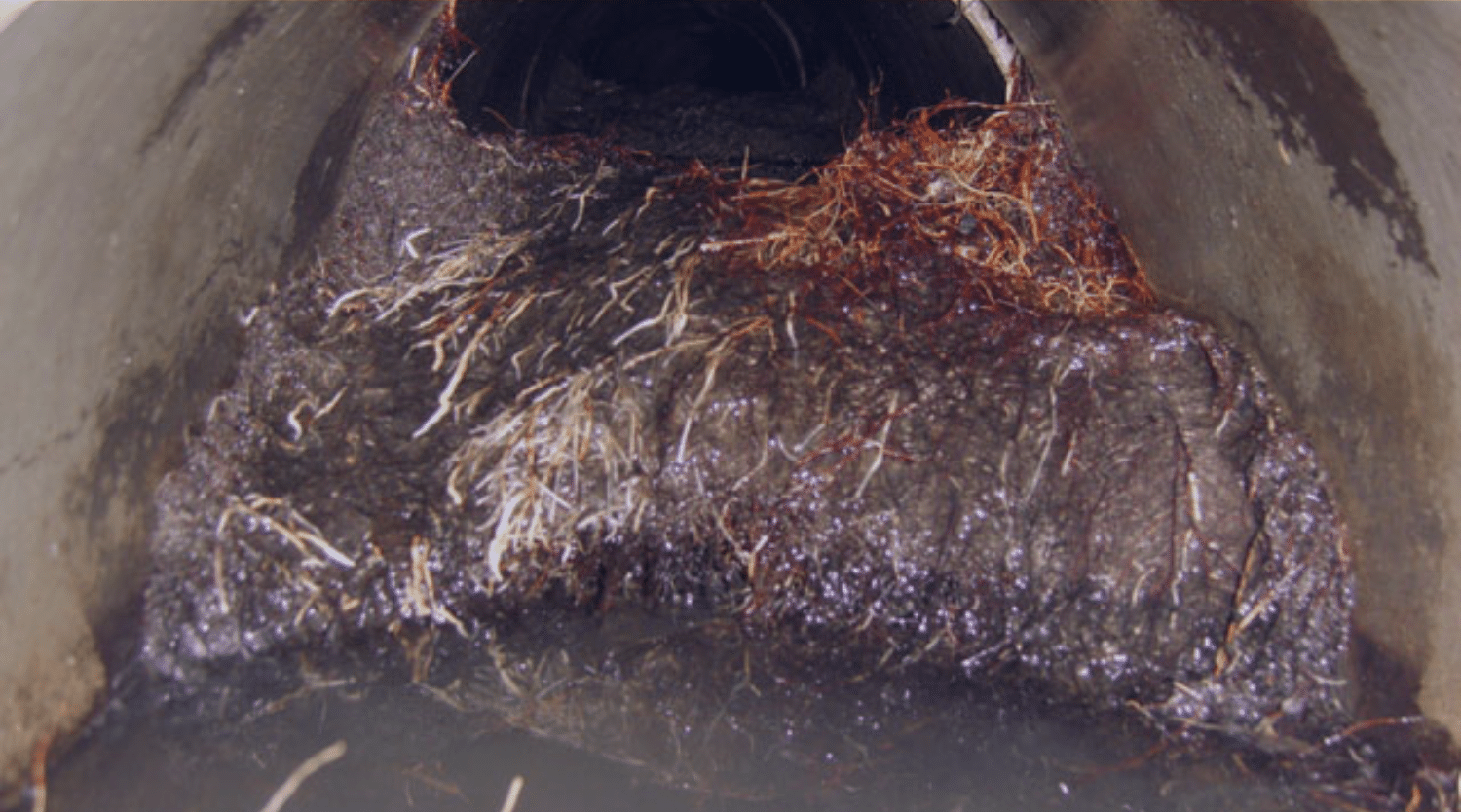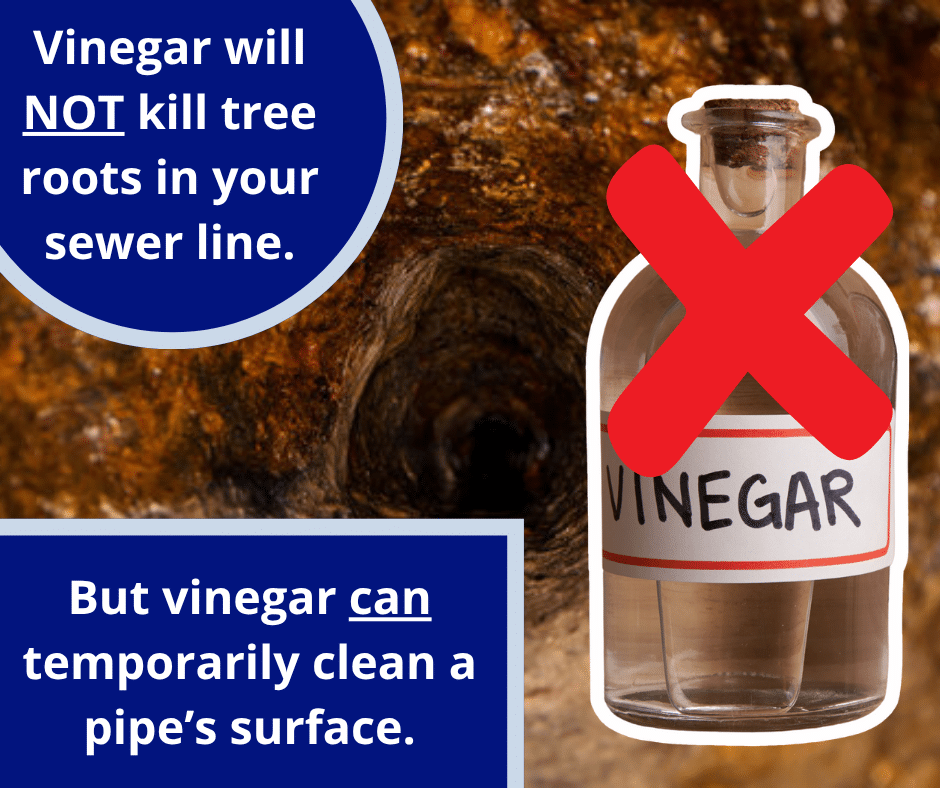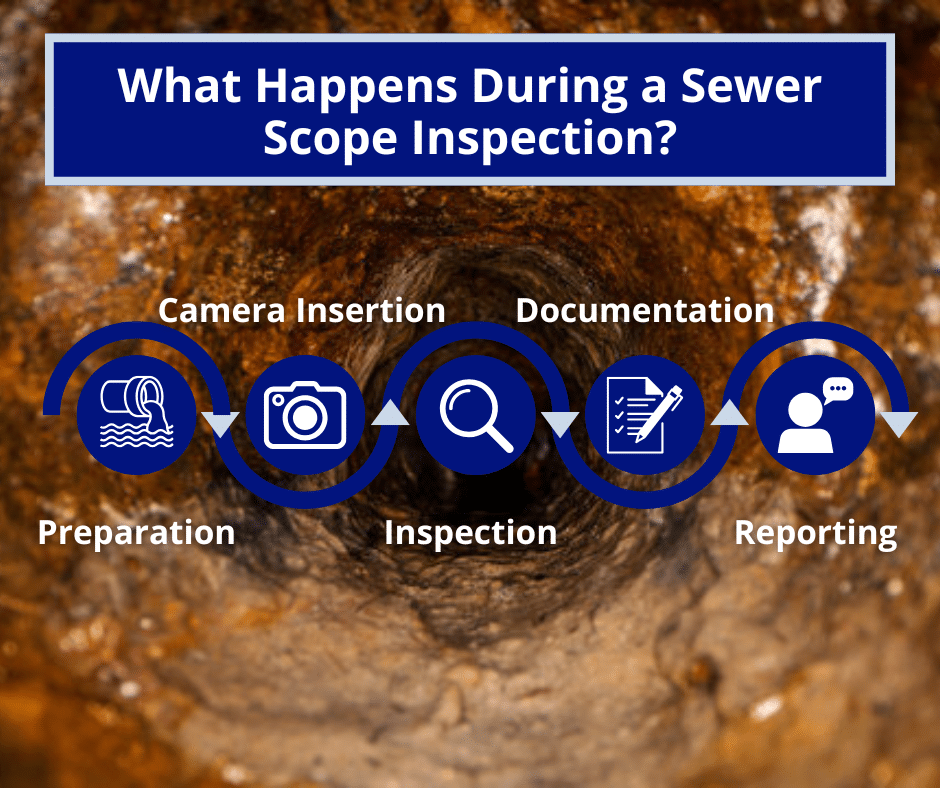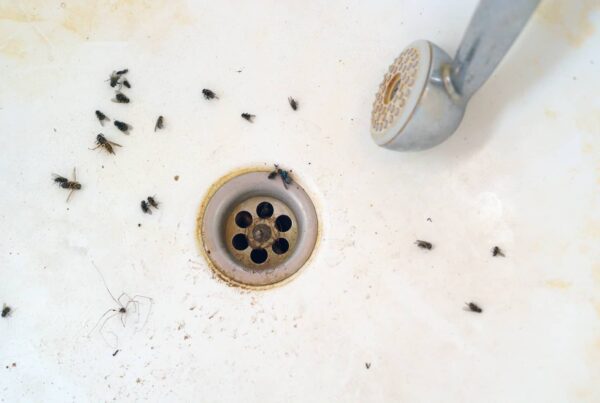
In Florida, strong root systems of nearby trees can sneak into underground sewer lines, causing clogs and costly plumbing problems. Many homeowners ask, “Will vinegar kill tree roots in the sewer line?”
The short answer is no. The best way to know what’s really happening underground is through a professional sewer scope inspection.
Here’s a closer look at why roots invade the sewer line, what resolves the issue best, and how homeowners can protect their pipes for the long term.
Why Tree Roots Get into Sewer Lines
Tree roots naturally grow toward moisture and nutrients, and your sewer line provides both. Even the smallest crack in a pipe can release water vapor, attracting roots that squeeze through tiny openings to reach the source.
In Florida’s warm, humid environment, trees like live oaks, palms, ficus, and magnolias have aggressive root systems that spread wide and deep.
Over time, those roots can work their way into older clay or cast-iron sewer lines, which are more prone to tiny fractures or loose joints. Even PVC pipes can become vulnerable if installed improperly or under soil that shifts during Florida’s frequent rainy and dry cycles.
Once roots find their way inside, they thrive. The constant flow of water and organic matter inside the pipe gives them everything they need to grow.
As they expand, roots begin to trap debris, restrict flow, and cause full blockages that affect your home’s plumbing.
Common Signs of Root Intrusion in Sewer Lines
Root intrusion doesn’t happen overnight, but the warning signs often start small. Here’s what to look for around your home:
1. Slow Draining Fixtures
If sinks, tubs, or showers are draining more slowly than usual, especially across multiple areas of your home, it’s often one of the first clues that roots are blocking part of the main sewer line.
Unlike a typical hair or soap clog, this kind of blockage affects several drains at once and worsens over time.
You might notice the bathtub draining more slowly after a heavy rainstorm, or your kitchen sink gurgling even when you haven’t been cooking, a hint that water isn’t flowing freely through your main line.
2. Gurgling Toilets or Bubbling Drains
When roots narrow the pipe, air pockets get trapped inside. You’ll hear bubbling or gurgling sounds when you flush the toilet or run water down a drain.
These noises mean the air is struggling to escape through blocked sections of the pipe.
Over time, gurgling can become more frequent, especially after large water usage (like showers or laundry). If left untreated, it may escalate to sewage backing up into your bathtub or toilet.
3. Frequent Backups or Overflowing Toilets
If you’re dealing with recurring clogs, especially in your lowest plumbing fixtures, roots could be to blame. A backup in the lowest point of your home, like a ground-floor toilet or shower drain, often points to a blockage in the main sewer line rather than a small branch line.
Homes built on slabs can experience root blockages that send wastewater back up into indoor drains. This is a serious warning sign that shouldn’t be ignored.
4. Unpleasant Odors Indoors or Outside
Roots can trap waste inside your sewer line, leading to foul smells escaping through drains or vents. Outdoors, you might notice a lingering sewage odor near your yard, driveway, or foundation, especially after rain.
Because Florida’s humidity holds odors longer, these smells can become strong quickly, a clear indicator that wastewater isn’t flowing properly underground.
5. Unusually Green or Damp Patches in the Yard
If a certain section of your lawn is greener, thicker, or constantly damp, it may not be due to your sprinkler system. It could signal a leaking sewer line caused by root intrusion.
Roots break into the pipe and create openings that leak nutrient-rich water into the surrounding soil. Grass and plants in that area may flourish, but beneath the surface, your pipe is suffering.
Because of sandy soil and frequent afternoon rain, Florida yards may hide small leaks for months before symptoms appear. Look for circular patches of lush grass or puddles that don’t dry quickly.
6. Sinkholes or Soft Spots Forming in the Yard
In more severe cases, constant water leakage caused by cracked pipes and root growth can lead to erosion under your yard. You might notice soft, spongy ground or even small depressions forming along the sewer line’s path.
In Florida, where limestone and sand make the ground naturally porous, these conditions can evolve into larger sinkholes if not repaired early.
7. Increased Pest Activity
It may sound odd, but pests like cockroaches, drain flies, and rodents are drawn to the same moist, nutrient-rich environment that roots create inside damaged pipes.
If you’re seeing unusual pest activity inside or near your home, particularly in combination with other plumbing issues, root intrusion might be part of the cause.
8. Sewer Clean-Out Overflowing
If you have a clean-out access point in your yard (a capped pipe sticking up near the house or curb), check it periodically.
If you see standing water, debris, or wastewater bubbling out, it often means the line beyond that point is blocked, commonly by roots or collapsed pipe sections.
Why These Signs Matter
The earlier you spot these signs, the easier and less expensive your repair will be.
Minor root growth can often be managed with hydro-jetting or chemical root treatment, but waiting too long can lead to full pipe collapse. This requires excavation or complete replacement.
If you notice any of these symptoms in your Florida home, the next step should be scheduling a sewer scope inspection with a trusted professional like Honor Services.
This inspection uses a small camera to confirm the presence of roots, assess pipe condition, and determine the most effective treatment before damage worsens.

Where the Vinegar Idea Comes From
Vinegar is often praised for its natural cleaning power. It’s safe, inexpensive, and great at dissolving soap scum or mineral buildup. Because of this, some homeowners assume it might also work for killing tree roots inside pipes.
Online DIY sources often suggest mixing vinegar with baking soda and salt, then pouring the mixture into a toilet or clean-out to “naturally kill roots.”
While this sounds appealing, it’s mostly a myth when it comes to actual root intrusion.
The reason? Vinegar’s acidity is simply too mild. Household vinegar contains only about 4–8% acetic acid, which isn’t strong enough to damage or kill established roots underground.
It may help freshen up your drains, but it won’t reach or destroy deep root systems growing inside a sewer line.
Does Vinegar Actually Kill Tree Roots in Sewer Lines?
The clear answer: No. Vinegar will not kill tree roots in your sewer line.
Here’s why vinegar falls short:
| Problem | Why Vinegar Doesn’t Work |
| Too weak | Household vinegar isn’t acidic enough to harm thick or woody roots. |
| Limited reach | Vinegar flows down the pipe but doesn’t cling to roots or penetrate blockages. |
| Depth of intrusion | Roots often grow deep underground, far beyond where vinegar can reach. |
| No repair effect | Even if it touches the roots, vinegar can’t seal cracks or prevent new growth. |
For example, if a live oak’s roots have entered a clay pipe joint, vinegar poured from a toilet won’t travel far enough or remain concentrated long enough to make a difference.
The result is a temporarily cleaner drain, but the roots keep growing.
Vinegar can clean a pipe’s surface, but it won’t solve the underlying issue of root intrusion.
When (and How) Vinegar Might Help
If your sewer line is clear and you want to keep it that way, vinegar can be part of a preventive cleaning routine. It’s best for maintaining healthy pipes, not for killing existing roots.
Here’s how to use vinegar safely as a light maintenance step:
- Find your lowest drain — typically the toilet closest to the main line or a clean-out access.
- Pour in 1 cup of white vinegar. Let it sit for 30 minutes.
- Add 1 cup of baking soda and a handful of salt. Let the mixture foam and sit for a few hours or overnight.
- Flush with hot water to rinse away any loose debris.
This can help remove small buildups and reduce the conditions that attract roots in the first place.
However, if you’re already seeing slow drains or soggy spots in your yard, vinegar won’t help. Those are signs of active root intrusion that require professional inspection and treatment.

Professional Methods That Actually Work
Once roots are inside your sewer line, professionals use proven tools and treatments to remove them safely and permanently.
Here’s what the team at Honor Services and trusted Florida plumbing specialists recommend:
1. Sewer Scope Inspection
A sewer scope inspection is the first and most important step. Using a small waterproof camera, inspectors look inside your sewer line to pinpoint blockages, cracks, or root growth.
This inspection takes less than an hour and provides clear video footage of what’s happening underground, essential for choosing the right repair method.
2. Mechanical Root Removal
Once roots are found, plumbers may use:
- Rooter machines (augers) that cut roots with rotating blades.
- Hydro-jetting, which blasts high-pressure water to clear debris and scrub the pipe walls clean.
These methods restore normal flow and remove immediate blockages, but follow-up treatment is necessary to prevent regrowth.
3. Chemical Root Killers
Specialized foaming or copper-based treatments are designed to kill roots inside the pipe without harming the tree.
Unlike vinegar, these professional products cling to pipe walls and penetrate root fibers effectively.
They’re safe for most sewer systems and help prevent roots from returning.
4. Pipe Repair or Replacement
If the roots have cracked or collapsed the pipe, repair is the only real fix. Professionals may:
- Re-line the pipe using a durable epoxy resin that seals cracks and creates a smooth interior surface.
- Replace damaged sections with modern PVC piping that resists root intrusion.
In Florida’s shifting, sandy soils, relining is often a faster and less disruptive option than full excavation.
How Sewer Scope Inspections Prevent Bigger Problems
At Honor Services, we use sewer scope inspections to identify root problems early, before they turn into costly damage.
A small camera is inserted into your home’s main sewer line through an access point. The video feed shows:
- The condition of your pipes
- Any signs of cracks, leaks, or standing water
- Root intrusion or other blockages
This visual confirmation takes the guesswork out of plumbing. Homeowners can see the issue for themselves and plan the right solution, whether that’s cleaning, treatment, or pipe repair.
Many Central Florida homes, especially those near large oak trees or built before the 1990s, have aging clay laterals that are prime candidates for root intrusion. Regular camera inspections can save thousands of dollars in emergency repairs.
Preventing Future Root Intrusion
Once your sewer line is clear, prevention is key. Here’s how homeowners can reduce future risk:
- Know your sewer line’s path. Mark its route before planting new trees or shrubs.
- Plant smart. Avoid large-root species like oaks, ficus, or willows near sewer lines.
- Replace aging pipes. Older clay or cast-iron pipes should be upgraded to PVC or HDPE.
- Keep your yard evenly watered. Dry soil encourages roots to seek out moisture from pipes.
- Schedule regular inspections. Have a sewer scope performed every 2–4 years, or sooner if your home is older or heavily landscaped.
- Use preventive treatments. Occasional safe cleaners (like vinegar or enzyme-based solutions) can help keep buildup low.
Related Questions
Can cutting visible roots in my yard solve the problem?
Not necessarily. The visible roots are only part of the system. Underground roots that have entered the pipe will continue to grow until they’re removed and the entry point is sealed.
Will vinegar damage my pipes or septic system?
No. Vinegar is mild and safe for PVC, cast iron, and septic systems. However, it won’t repair cracks or stop leaks.
How soon can roots regrow after removal?
In Florida’s warm climate, roots can regrow in as little as six months if cracks remain. Preventive treatments and regular inspections help stop them from returning.
Does homeowners’ insurance cover tree root damage?
Usually not. Most policies exclude damage caused by gradual wear, such as root intrusion. However, sudden drain backups or overflows might be partially covered; check with your insurer for details.
What’s the best long-term fix for root intrusion?
Professional inspection, mechanical clearing, and pipe relining or replacement provide lasting protection. These steps stop regrowth and restore full function.
Conclusion
In short, vinegar won’t kill tree roots in your sewer line. It’s useful for light maintenance but not a true solution to root intrusion.
If you’re noticing slow drains, foul odors, or soggy areas in your yard, it’s time for a closer look. Honor Services offers professional sewer scope inspections across Brevard County and surrounding Florida communities. Our inspections show you exactly what’s happening underground so you can make the right choice before the problem worsens.



